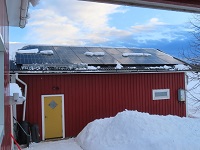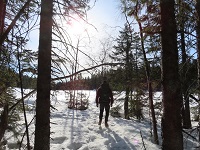2022-02-15 Radon Mitigation Planning
I purchased a Radon meter for the basement. I was planning on using the basement more and figured that similar to a CO meter and a smoke alarm, a Radon meter was sensible to have, if a bit expensive.
As soon as I installed it, it gave a reading of 900Bq/m3 in the basement. The vendor says to give the detector time to calibrate and become more accurate. I did wait but it became clear that the readings weren’t going to change all that much.
The domestic Airthings radon meter I used isn’t as accurate as a professional meter. But, it should be within 10% according to various Radon mitigation professionals. It settled down to be between 450-800Bq/m3 in the lowest level of the basement.
The level for recommended mitigation action is 100 or 250Bq/m3 depending on the country you’re in. As a bit of background, there’s no safe level for Radon. It is a heavier-than-air radioactive gas that occurs from tiny amounts of uranium in the soil. It causes elevated chances of lung cancer based on duration and level of exposure. Despite being heavier than air, the movement of warm air is enough to take it to the floors above. The levels in the basement will remain higher due to being closer to the source.
Possible improvement: Ventilation
I started looking online and watching various Youtube Radon mitigation advisors videos. I wanted to see what people agreed and disagreed on. Other people had noted that installing mechanical ventilation halved the levels. The consensus was that it was treating the symptom rather than the cause. Many people noted that the ventilation also helped the house in other ways.
I thought that the cause of the Radon in our house was going to be the cracked basement floor allowing soil gas in. Or a potential area where a hole in the slab appeared to lead to exposed earth.
Possible improvement: Stop gasses from the soil seeping in
Replacing a concrete slab is simple enough in good conditions and with enough people. For me it was -20C outside and snowing, and I would be doing it all myself.
I’d already over exerted myself on a previous project. I did a 6m2 slab in the food cellar myself. It had been fine until my back gave out at the end of the project and I couldn’t walk for 2 weeks. Looking at this project, the largest broken concrete slab is roughly 7.5m x 4m which is 30m2. Five times the size of the previous project.
So in short replacing the slab is something best left to late spring and summer. It is also not a small project, and will need some careful planning.
Possible improvement: Depressurise and vent the soil
Under-slab ventilation of the soil or ventilation by pulling air from the soil outside the house are other methods. But these methods are not simple.
The American guides on external soil depressurisation ask for a 4m deep hole. That needs special equipment.
The under-slab ventilation results in a 4-inch pipe running above your roofline. Fitting would have to wait until the snow was gone and will look ugly. I’d prefer more options.
Kommune Support
I checked online on the local council (kommune) website in case there were grants for this type of work. There had been financial grants for radon mitigation, but it ended last year. Drat.
I contacted the kommune and found out that in 2011 the property had a radon reading taken. They had recorded a six month average of 100Bqm in the bedroom and 100Bqm on the ground floor. Not great but not horrific. I was a bit suspicious of the historical readings. I thought there would be a lower reading upstairs than the ground-floor living room. But lightness of the gasses and the movement of heating air is enough to take radon upstairs.
I wondered if the risk might have changed since those readings a decade ago. My theory was that as the owners over time had improved insulation it had reduced air exchange. Also, the house heating method had changed from burning/using air via wood or oil, and to a ground source heat pump. As a result air was no longer going up the chimney and replaced with fresh air leaking in from outside.
Ways Forward
I can put in standard ventilation, but if I pull in -20C air from outside the basement will become cold. In cold climates, you have to use a heat exchanger or you’ll need something like 2kw of heat for incoming air at -20C. Mechanical air ventilation brings other benefits such as removal of stale air. Everyone who has had one fitted says it’s worth the tiny bills increase to have constant fresh air.
But there are complications. Heat exchangers (ERV or HRV) are expensive in Sweden. Besides the cost of the core unit, fitting is a major cost. To duct air around a large basement, you need a lot of equipment. The ventilation unit is a major expense. But installation includes ventilation pipe, pipe hangers, pipe angle brackets, and pipe insulation. It also needs external vents that are mouse and weather-proof.
An extra complication is present when getting air to and from the outside world. There’s a basement window opening that a previous owner has filled with concrete that I can use. But it would likely need rebuilding. For new mortar or concrete to set, the temperature must also be above 2c or risk a weak construction. The external facade is rockwool and metal siding. The metalwork will need cutting tools and tidy ufinishing.
Summary
There are a lot of problems connected together. I’ve planned a basement ventilation system and will collect all the parts I need. I’ll construct the indoor work needed, and then wait for spring to finish the external venting. In the meantime we are opening the window when we have to go into the basement, and avoiding spending time in it, to reduce exposure.
Once the ventilation is in place, I’ll work on renovating the floor of the basement. That will give the chance to put in a sealed sump pit. The pit can operate for future flood prevention or as a point for under-slab venting and depressurisation.
I’ll post lots of photos online as the projects develop.

